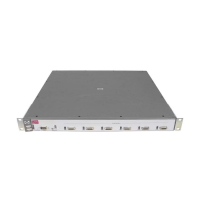Static Virtual LANs (VLANs)
VLAN Restrictions
Jumbo Packet Support on the Series 3400cl and Series
6400cl Switches
Jumbo packet support for the 3400cl and 6400cl switches is enabled per-VLAN
and applies to all ports belonging to the VLAN. For more information, refer to
the chapter titled “Port Traffic Controls” in the Management and Configura-
tion Guide for your switch. (Jumbo packet support is not available on the
Series 5300xl switches.)
VLAN Restrictions
■ A port must be a member of at least one VLAN. In the factory default
configuration, all ports are assigned to the default VLAN
(DEFAULT_VLAN; VID = 1).
■ A port can be a member of one untagged, port-based VLAN. All other port-
based VLAN assignments for that port must be tagged. (The “Untagged”
designation enables VLAN operation with non 802.1Q-compliant devices.)
■ A port can be an untagged member of one protocol-based VLAN of each
protocol type. When assigning a port to multiple, protocol-based VLANs
sharing the same type, the port can be an untagged member of only one
such VLAN.
■ With routing enabled on the switch, the switch can route traffic between:
• Multiple, port-based VLANs
• A port-based VLAN and an IPv4 protocol-based VLAN
• A port-based VLAN and an IPv6 protocol-based VLAN
• An IPv4 protocol-based VLAN and an IPv6 protocol VLAN.
Other, routable, protocol-based VLANs must use an external router to
move traffic between VLANs. With routing disabled, all routing between
VLANs must be through an external router.
■ On the 3400cl and 6400cl switches, and on 5300xl switches running a
software version earlier than E.09.xx, prior to deleting a static VLAN, you
must first re-assign all ports in the VLAN to another VLAN. On 5300xl
switches running software version E.09.xx or greater, you can use the no
vlan < vid > command to delete a static VLAN. For more information, refer
to
“Creating a New Static VLAN (Port-Based or Protocol-Based) Changing
the VLAN Context Level” on page 2-33.
2-53

